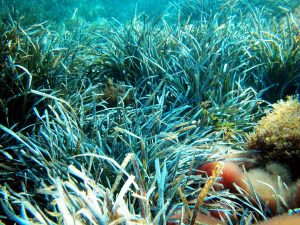“We need to protect and preserve these vulnerable ecosystems. However, the best environmental protection strategy to keep oceans free of plastic is to reduce landfills, an action that requires to limit its use by the population.”
.
Seagrass can both provide natural habitats and capture carbon:
Seagrass in Lyme Bay – Vision Group for Sidmouth
.
Apparently, it can also capture plastic:
.
 Posidonia marine seagrass can catch and remove plastics from the sea
Posidonia marine seagrass can catch and remove plastics from the sea
A trap for plastics in coastal areas
Posidonia oceanica seagrass — an endemic marine phanerogam with an important ecological role in the marine environment — can take and remove plastic materials that have been left at the sea, according to a study published in the journal Scientific Reports…
“Everything suggests that plastics are trapped in the Posidonia seagrass. In the grasslands, the plastics are incorporated to agglomerates of natural fiber with a ball shape — aegagropila or Posidonia Neptune balls — which are expulsed from the marine environment during storms,” notes Anna Sànchez-Vidal, member of the Department of Ocean and Earth Dynamics of the University of Barcelona…
The new ecosystemic service of the Posidonia described in the article has a significant value in a marine area such as the Mediterranean — with high quantities of floating plastic and in the seafloors — and with Posidonia seagrass that can occupy large areas up to forty meters deep…
“This is why we need to protect and preserve these vulnerable ecosystems. However, the best environmental protection strategy to keep oceans free of plastic is to reduce landfills, an action that requires to limit its use by the population,” conclude the experts.
.
image: File: Posidonia 2 Alberto Romeo.jpg – Wikimedia Commons